This year, in 2024, we are celebrating the 200th birthday of an inventive and revered composer of the late 19th century, Anton Bruckner. Having performed his symphonies many times, what better way to honor the composer than to make a visit to St. Florian Monastery and his burial place? Just recently, I was able to strike this off my bucket list in an exceptional way: not only touring the Monastery and seeing Brucker memorabilia but also hearing a wonderful concert performed by the Akademie für Alte Musik Berlin in the Monastery Garden.
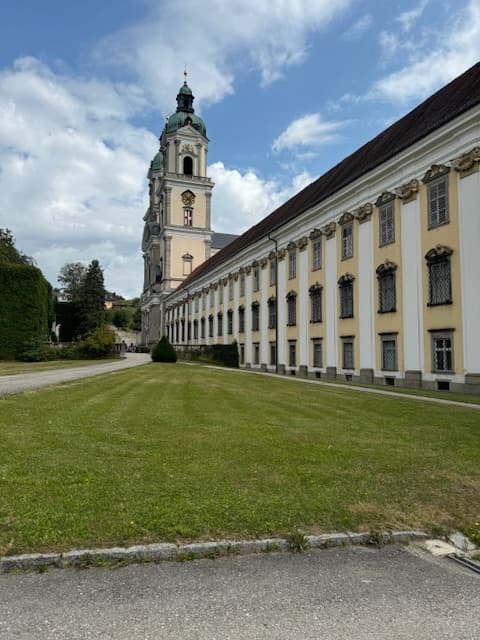
St. Florian Monastery
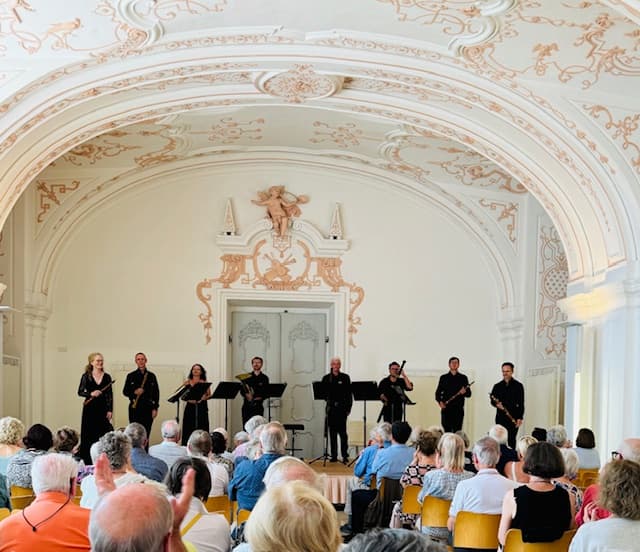
St. Florian Monastery concert
From May 4 to October 27, 2024, St. Florian Monastery is hosting a major exhibition to celebrate. On display are a number of documents from the archives, which we were able to experience as part of a wonderful journey with Martin Randall Travel.

St. Florian Monastery – the Halls
The stunning abbey, founded in the eighth century, refounded in 1071 by the Augustinians, then rebuilt in 1686, is considered one of the finest Baroque edifices in Europe. Located in Sankt Florian, Austria, near Linz, there are magnificent frescoes including on the ceilings, an outstanding library that caused me to gasp in wonder with 160,000 historic volumes and manuscripts on wooden carved shelves and a breathtaking frescoed ceiling, ceremonial and grand staircases, an Imperial Marble Hall of scagliola “artificial” marble decorated in the Hapsburg Monarchy colours of red white and yellow, and two magnificent organs, played and beloved by Anton Bruckner himself. The “Bruckner organ”, one of the largest in Austria, has four manuals, 103 stops, and 7,343 pipes, but what is most impressive is the ornate, decorative elements, carvings, and sculptures.
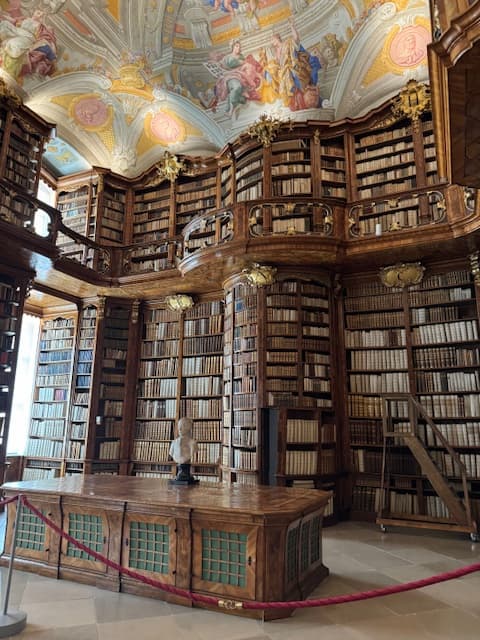
St. Florian Monastery – Library
In my early years in a youth orchestra, I performed the magnificent Symphony No. 4 in E-flat major, “The Romantic,” for the first time, one of the composer’s most popular symphonies. The glorious horn lines, lyrical string writing, step-by-step building of climaxes, and folk-like tunes had us, when we weren’t rehearsing, singing the themes in harmony at the top of our lungs! The scherzo is dramatic music that was unforgettable to a budding musician.
Anton Bruckner: Symphony No. 9 in D Minor, WAB 109 (original 1894 version, ed. L. Nowak) – II. Scherzo: Bewegt, lebhaft – Trio: Schnell (Stuttgart Radio Symphony Orchestra; Carlo Maria Giulini, cond.)
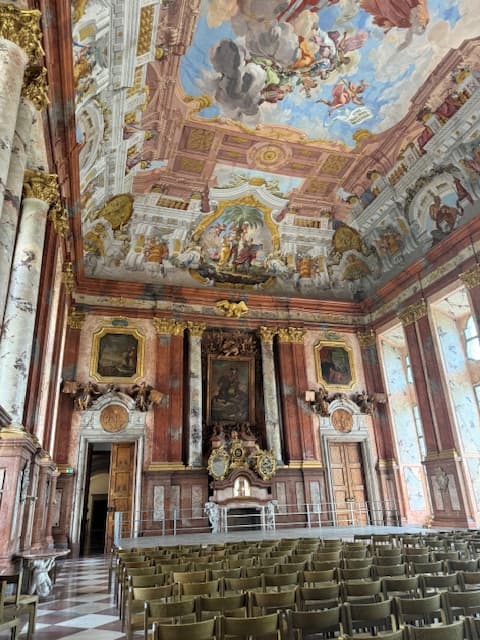
St. Florian Monastery – Marble Hall
Bruckner is noted for his nine symphonies and his sacred music—his masses and motets, especially Locus iste, Christus factus est and Ecce sacerdos magnus, and his Te Deum. Here is the Locus iste beautifully sung by the St. Florian Boys Choir.
Anton Bruckner: Locus iste, WAB 23 (St. Florian Boys’ Choir; Markus Stumpner, cond.)
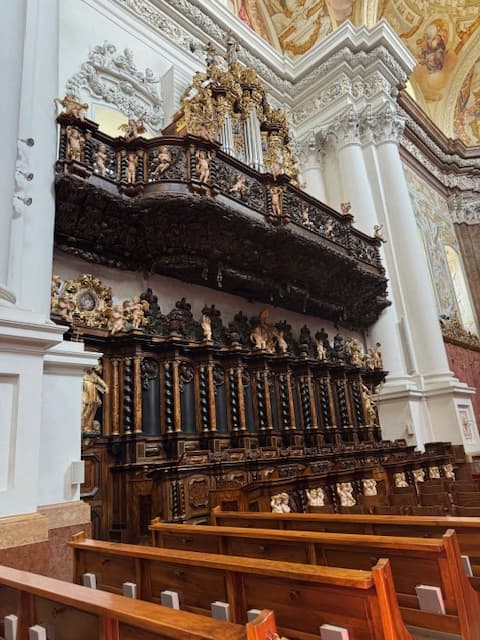
St. Florian Monastery – Smaller organ
I was thrilled to trace the composer’s life here at St. Florian. Bruckner began his musical days as a choirboy for the St. Florian Boys Choir, and his studies continued in singing, and on the violin and organ. Later, from 1845-1855 he was a teacher and the organist here and in 1875 Bruckner was appointed lecturer at the University of Vienna. The monastery celebrates their native son with several rooms containing Bruckner’s early sketches, his furnishings and belongings, and his piano, which are on display.
After we visited these exhibits, we descended into the darkness of the 700-year-old crypt, the air becoming cooler and clammy. I have to say I was taken aback by the sight in front of us. Bruckner is surrounded by hundreds of ancient companions down there! Behind the sarcophagus, there is an enormous and carefully stacked pile of skulls and skeletal bones–6,000 Christians who have been buried here since Roman times. Bruckner’s remains are encased in a silver casket placed directly below the organ, ostensibly so he can hear the instrument resounding in the crypt when it is being played in the Basilica above.
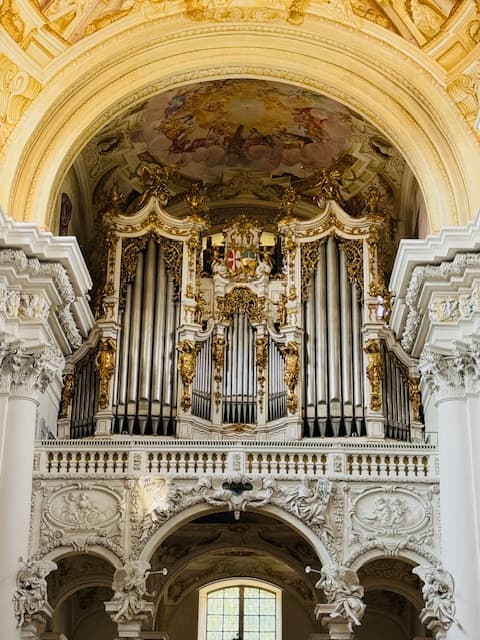
St. Florian Monastery – Bruckner organ
After our tour of the premises, we were treated to a marvelous program by the Akademie für Alte Musik Berlin (AKAMUS). The program included the Armonia per un Tempio della Notte in E-flat by Antonio Salieri, and W. A Mozart’s Serenade No. 11 in E-flat K. 375 and Serenade No. 10 in B-flat K. 361/370a Gran Partita.
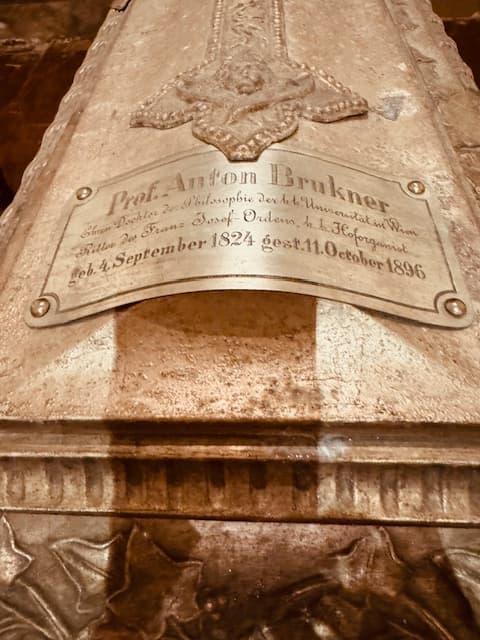
St. Florian Monastery – Bruckner’s crypt
The AKAMUS, founded in Berlin in 1982, recently celebrated their 40th anniversary. For over 35 years, the orchestra has been playing a subscription series at the Konzerthaus Berlin. They also appear at the Berlin State Opera, performing baroque opera, and they’ve been regular guests at Munich’s Prinzregententheater since 2012. A leading chamber orchestra that performs over 100 concerts annually on period instruments the world over, we heard a reduced ensemble of two oboes, two basset horns, two clarinets, two bassoons, four horns, and double bass. They played with utmost finesse. The quality of sound the group attained was remarkable and elegant, with a lively, engaging, and finely polished interpretation. I thought the many ornamental flourishes were played with grace and flair, especially in the Gran Partita Theme and Variations.
Wolfgang Amadeus Mozart: Serenade No. 10 in B-Flat Major, K. 361, “Gran Partita” – VI. Tema con variazioni (Berlin Akademie für Alte Musik, members)
Akademie für Alte Musik Berlin (AKAMUS)
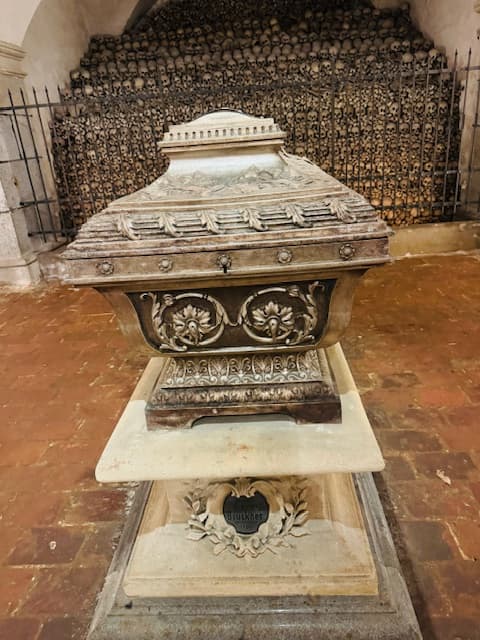
St. Florian Monastery – Skulls and skeletal bones
One doesn’t often hear Salieri, and despite the rumors that swirl around his supposed rivalry with Mozart, he was a much sought-after and respected teacher in his day. I was pleasantly surprised by the single-movement work scored for the same instruments as Mozart’s K. 375, featuring the silky sound of the clarinets.
Antonio Salieri: Armonia per un tempio della notte (Ensemble Philidor)

St. Florian Monastery – Janet Horvath with Bruckner’s piano
What an exceptional experience and a privilege to have had this opportunity. If you are in Austria and have a chance, I highly recommend a side trip to the gorgeous St. Florian Monastery.
For more of the best in classical music, sign up for our E-Newsletter


